“Ramone’s Bakery.”
“Hi, may I talk to your baker?”
Jon Norris, the daytime baking production manager at Ramone’s on Harrison in Eureka, gets on the phone.
“Do you make thimbleberry pie? Or tarts, or scones, or cookies, or ... ?”
“I don’t know anybody who uses thimbleberries,” says Norris. “You couldn’t get enough of ’em in the time it took to pick them. If somebody came in with thimbleberries, I don’t know what I’d do with ’em. But I like thimbleberries. As a kid I liked ’em because you could walk into the woods and find ’em. I would almost compare it to a raspberry. But it’s not commercially grown around here -- it’s a lot of picking to get a pound.”
Dee-dee-dee-dee-dee-dee-dee . (That’s my phone dialing. Now it’s ringing.)
“Brio.”
“Hi, do you guys use thimbleberries in your baked goods?”
“Thimble what?”
It’s lunchtime, it’s loud, they’re busy. And I never do get back to their baker. But I’m guessing it’s a “no.”
Mad River Farm Kitchen makes jam. I leave a message on the machine, and the next day Marika Myrick phones back. Nope she says, they don’t do thimbleberries.
Kjirsten Wayman stands in the trail and gently rubs the back of a thimbleberry leaf with her fingers. She holds her hand to her nose and smiles.
“It was seven years ago, in early July, when I came out here [to Humboldt] to look for a place to live,” she recalls. “I went walking around Trinidad Head with Bill Wood, another organic chemist, and he saw these thimbleberries and said, ‘Taste one.’ So I tasted one -- and they’re so good. They’re kind of like a raspberry, subtle and yet really tasty. And I was rubbing the leaf, and if you rub the back of one of the new leaves, there’s a fruity, herbally smell.”
It’s a sunny day in the Arcata Community Forest. Wayman is an organic chemistry professor at Humboldt State. She has blue eyes and long, wavy blond hair. And she has a superpower nose. She can smell carrots. Her friends tease her about it. Since that day on Trinidad Head seven years ago, the thimbleberry has become her favorite plant. The smell has haunted her. It’s a bit like lemon. Or pine. Or both.
She wants to know what the compounds are that give it that scent. So she’s heading off to New Zealand to spend the summer working with the Plant Extracts Research Unit at the University of Otago, learning extraction techniques.
“Stems, leaves, roots -- you separate out all the individual compounds and identify them,” she says. Nobody’s done this for the thimbleberry. She’ll come back to HSU, carve out a spot in the tiny, underused laboratory space allotted the chemistry department, and be the first.
Often, she says, scientists do close, chemical studies of a plant because they want to discover new compounds that may have some sort of practical application -- in medicine, for example. But she’s more interested in providing an interesting project for her botany students. And just pure discovery.
“It smells so good, and I want to know what that structure is,” she says
As we leave the forest, Wayman shares some thimbleberry intelligence with me.
“Now, this is off the record,” she says. “But you know that road [snip] off of [snip]? Well, there are certain sections in there that are loaded with thimbleberries.”
Enough for jam? A pie?
Probably not, she says. “And it’s also really fragile. When you pick a thimbleberry it mooshes right there, and so you have to eat it. You have to eat them all right there. If you were to find 10 ripe ones all at once, that would be a great thing. That would be a lot.”
If you were starving, you’d do better to hunt the generous all-at-once clusters of salal, or the late-summer fruiting huckleberry. Or the ubiquitous blackberry. But the thimbleberry has a taste like no other -- an intense, tart-sweet smoldering on the tongue. It’s not quite like anything you’ve ever tasted before. Claire -- she works in my office -- tasted her first thimbleberry the other day. “They’re kind of fruity on the back of your tongue.” Pause. “It has this initial burst of flavor -- it’s concentrated, but it’s delicious. It’s not wimpy. It’d be wonderful to make a compote with it.”
Here’s the thing about thimbleberry, though. You can find it in backyards and along trails, no problem, but its berries seem to go off one at a time. It flowers throughout its fruiting season -- which is short, mostly in July -- so one plant can have a flower with a bumblebee spinning inside, next to a group of berries, which might be anywhere from hard green to pale pink to ripe, dark red.
The western thimbleberry, Rubusparviflorus Nutt., stands tall. It’s a member of the rose family -- Rosaceae -- and related to blackberries. But unlike all of its relations , R. parviflorus has no prickles. Its leaves are different, too: huge, simple, maple-shaped and covered in tiny soft hairs that make it as soft as Charmin. The leaves alternate up the tall stocks. And, though “parviflorus” means “small-flowered,” the thimbleberry has one of the largest flowers in the rose family.
The thimbleberry was misnamed back in 1818, when English naturalist Thomas Nuttall set foot on an island in Lake Huron and unwittingly grabbed an unusual specimen. It had small white flowers, but today botanists recognize that the norm for R.parviflorus is big white flowers.
As for Rubus , that means “brambling,” and the thimbleberry “doesn’t do the brambling thing,” says Robin Bencie, taxonomy professor and collections manager for the herbarium at Humboldt State University. “It doesn’t make those arching branches, with the re-rooting stem tips,” like blackberries do. But the thimbleberry’s large leaves and its tendency to grow close together and spread through its roots, sending up new shoots, makes it capable of becoming a wall of green that can tower five feet or higher, especially in sunny places.
The berry itself is strangely compact. Like blackberries, says Bencie, the thimbleberry’s berry is a coalescence of a bunch of tiny little fruits that merge to form one entity. But the thimbleberry seems to have more of these per berry -- think of them as tiny, individual cherries -- and the result is a dryish, soft, seedy morsel.
“I love the flavor of thimbleberry,” says Bencie. “I describe it as eating red velvet. They’re not as juicy as blackberries. But I don’t know why people don’t just add water!”
Another distinguishing feature: When you pick a blackberry, the fruit falls off the stem, pithy “receptacle” (female part) and all. When you pick a thimbleberry, or a raspberry, the aggregate fruit peels off, leaving behind the receptacle. That leaves you with a hollow berry that can fit on the tip of your finger. Just to confuse things, consider their relative, the strawberry: “It’s equivalent to the receptacle left behind on a raspberry,” says Bencie.
According to a USDA database on R. parviflorus , with a few exceptions the thimbleberry ranges from “useless” to “fair” in terms of food and cover for most wildlife. Everybody will eat some part of it, at some time. Some black-tailed deer in Oregon really like its green shoots. Most mule deer love it. Moose in northwestern Wyoming gobble up the shrub in the summer. And various rodents like to nibble on its bark, which turns a peeling gray as it ages. And it can be an important food for birds. Still, the USDA site says that thimbleberry is “rated as poor in energy and protein value.”
Thimbleberry isn’t rare on the North Coast. It’s all over Trinidad Head, it’s in generous clumps in the Arcata Community Forest and it forms intermittent hedges alongside just about every road leading into the mountains. It thrives on the dry slope of Horse Mountain. Prevalent in the West, R. parviflorus leaks into an outpost in South Dakota, and then flourishes around the Great Lakes states. It can grow in nearly any soil condition -- as long as there’s some water -- and at elevations ranging from sea level to 8,000 feet. It can spread by seed or root. It loves disturbed areas.
“On Monday, I was on the Mill Creek Lakes Trail with my class (up behind Hoopa),” writes Bencie in an e-mail. “The trail begins in an area that was burned relatively recently. Although most trees were still present and only burned about 10-15 feet up the trunk, the forest understory had been completely burned. Guess what the dominant, most common shrub coming back was? Yep, thimbleberry.”
Dee-dee-dee*-dee-dee-dee-dee-dee. Ring. Ring.*
“Wood’n Spoon.”
“Hi, I see you make thimbleberry jam. We don’t, out here in California. I wonder why that is?”
The man on the other end -- Bruce Beaudoin, owner of Michigan’s Wood’n Spoon -- considers a moment, then says, “They grow so well around here. It’s a good berry producing area. I go through 500 pounds myself, a year. We pay [pickers] about $10-$11 per pound for ’em.”
“Here” is the Keweenaw Peninsula -- specifically, the “Copper Country” of Michigan’s Upper Peninsula. Beaudoin says they have thickets of wild thimbleberries, and that there are several other jam makers in the area, and “everybody’s got their secret patch.” And although there are enough berries to make jams and jellies, even in Keweenaw the thimbleberry is a special treat, because compared with other types of berries it’s an underproducer.
“I make thimbleberry syrup, vanilla-thimbleberry sauce and thimbleberry jelly,” says Beaudoin. “And then I make five different-sized jars of thimbleberry jam. I sell mine for $9.50 per 8 oz. The monks, I think they are getting $13 a jar, but then they’ve got the religious thing going.”
Monks? The Holy Transfiguration Skete, Society of St. John, runs a business called The Jampot. And, yes, their website displays some slightly higher pricing. The monks don’t answer my e-mail explaining my mission to find out why they make thimbleberry jam. But it is thimbleberry picking season, so they are forgiven.
“Some grad student up here did a master’s thesis on the thimbleberry,” Beaudoin adds, a tinge of skepticism warping his Midwestern tone. “Whether it was worth a thesis, I don’t know.”
This 2003 thesis, on the Keweenaw Peninsula’s jam industry, turns out to have been researched and written by a Michigan Tech forestry grad student named Jason Anderson.
“Thimbleberries are harvested in much the same way as other non-timber forest products, though the production and sale can be said to be in transition from an informal economic setting to a more formalized system,” Anderson writes. “The average jam production business is small and family-oriented. The average method of sale for thimbleberry jam is to small businesses or individuals through close-knit buyer-seller relationships.”
OK, it’s niche. But this weekend Keweenaw County is celebrating its 8th Annual Thimbleberry Festival, complete with thimbleberry sundaes.
“A festival?!” cries Tharon O’Dell, a forester with Green Diamond Resources’ California Timber Division, over the phone. “You’d be hard-pressed to get a festival going here for thimbleberries. And it’d be a pretty weird group of people if you did. Have you tried them? They taste like a caterpillar. They’re hairy.”
They are hairy. And the seeds, though soft, are many, and get stuck in your teeth. O’Dell says even wildlife “underutilize” thimbleberries.
“I’ve eaten them from Canada to Northern California, I’ve worked all over the country cruising for wood, and I never found one where I thought, ‘By gawd, here’s a secret patch I’m going to go back to.’” O’Dell says the plant doesn’t cause any trouble, as it apparently does in some places -- shading out young tree seedlings trying to sprout.
Just about all thimbleberry i s good for, he concludes, other than as an incidental snack for an animal or bird, is if you want a “weed mat” for erosion control, or for soil amendment. (The leaves fall off in the winter.)
For eating, O’Dell prefers the sweet Himalaya blackberry, even though it is an exotic (non-native), and the smaller, more tart, native California trailing blackberry. And for aesthetics -- don’t get him started. “One of my favorite shrubs is the oso berry -- Indian plum, Oemleria cerasiformis ,” he says. “It’s one of the earliest indicators of spring. It comes out with the willows. And I like Amelanchier alnifolia -- Western serviceberry. It’s got gorgeous delicate flowers. And on dry sites, I like ocean spray -- Holodiscus discolor. It has a very nice creamy flower that’s sensitive to breezes; it almost seems to be alive. And it has a small, distinctive leaf, like a mitten. And really straight stems -- Native Americans made arrow shafts with it. And of course, inland, there’s redbud. It’s such a gorgeous color.”
He mentions more, but it’s time to move on -- he’s made me think of poetry.
“Hi, this is Jerry Martien.”
“Oh, hi! I was wondering, have you ever written an ode to the thimbleberry?”
“Thimbleberry? No, I haven’t written an ode.” There’s silence on the line as the locally beloved poet pauses. “It would be a very small, quiet ode. They’re not very sweet berries. Though they are the first pale sign of spring ... Sort of seeing them floating in space ... Wait -- maybe that’s not the thimbleberry I’m thinking of.”
“Maybe you’re thinking of the salmonberry?”
“Yes, maybe that’s the one. You’d better stick with talking to the scientists!”
But it’s a common mistake. Some supposedly scientific guides to edible plants have been known to say that another name for thimbleberry is salmonberry. They’re wrong: The salmonberry’s leaves are compound, like a blackberry’s, not simple. It has prickles. Its berries are big, fat and juicy -- and not very sweet.
Like the thimbleberry, though, the salmonberry plant grows tall and lofty, as opposed to arching and brambly. The salmonberry’s fruits are also few and far between -- and they do seem to float, dangling orange orbs in green space. They’re ode-worthy, too.
A Swainson’s thrush trills from the red elderberry bush as Jim Popenoe stands poised with a long-nosed shovel in a sunny patch of his sprawling, picture-perfect garden near Patrick’s Point State Park. The ocean’s close by -- you can hear the barking of the sea lions resting on sea stacks below the cliff.
Popenoe has cultivated everything here: azaleas, currants, thimbleberries, huckleberries, salmonberries, poisonous twin berries and more. He pushes the shovel into the ground and heaves up a small thimbleberry stock. He walks it over to a shady, bare spot in another part of the yard, digs a hole there, and puts the transplant in. They’re a choice landscape feature: graceful, leggy and tall in the sun, shorter and showy in the shade, with stocks that last two to three years before dying. And, always, young stocks coming up from the rhizome spreading underground. The only plant he discourages is the Himalaya blackberry. He rips it out as soon as it shows its face, and maybe plops a thimbleberry in there to quell it.
Popenoe, a retired plant ecologist and soil scientist who worked for Redwood National Park, says they’re easy as pie to propagate. So, why doesn’t anyone really go to town with them commercially?
“Now, isn’t that an interesting question,” he says. “Maybe we should start a movement.”
Later I find out that Rick Storre, cofounder of Freshwater Farms and the North Coast Native Seed Bank, does grow thimbleberry plants to sell. “We have sold, since about 2000, 543 one-gallon thimbleberries,” he says. “I bet it’s a lot for restoration work.”
Storre says he loves the berry.
“But I’m not Mr. Domestic,” he says. “I’m not gonna make jam out of it.”
Dr. Larry Alice, of the Department of Biology at Western Kentucky University in Bowling Green, says he can’t really speak to the jam question. Or even to thimbleberry’s unique place in the world. It’s one of the less interesting species in the Rubus genus, in fact. Simple leaves. No prickles, which according to Alice means that it’s “one of the more ancestral groups within Rubus .” It evolved earlier in time than the more complex species in Rubus , which developed prickles.
Alice is interested in the genus as a whole. “I selected Rubus as a group to study because of its taxonomic difficulty, economic (fruit crops and ornamentals) and ecological (invasive weeds) importance, and overall abundance (found on all continents except Antarctica and particularly common in the Northern Hemisphere),” Alice says. “ Rubus is arguably the most difficult plant genus in the world taxonomically.” And that, he says, means he’ll have “a lifetime of work.” He hopes to write the master book on Rubus someday -- a monograph, with illustrations and photos.
But he does offer one neat historical note about R. parviflorus . It’s nearest relative is Rubus odoratus , purple-flowering raspberry, found in the eastern states and provinces.
“Both of these species shared a most recent common ancestor at some point in time, and I suspect that this species may have been found throughout North America during a period when the climate was cooler and wetter than present,” Alice says. “Following the Pleistocene glaciation 8,000-12,000 years ago, the Great Plains region became hotter and drier. Consequently, R. odoratus retreated to the east and R. parviflorus went west. The only region of overlap today is in northern and upper peninsula Michigan and Wisconsin. Where both species occur, hybridization has been documented.”
Native American Ethnobotany, a database based at the University of Michigan-Dearborn’s website, contains a list of more than a hundred uses of thimbleberry by indigenous people, from medicinal to culinary. Blackfoot “diviners” gave the berries to people with pulmonary disorders. The Cowlitz applied a poultice of dried leaves to burns. The Karuk made an infusion of roots to treat “thinness” (to stimulate the appetite). The Kwakiutl decocted the leaves to treat stomach trouble. The Okanagan-Colville used a root mixture to treat pimples and blackheads; their young people also rubbed the leaves on their faces for the same purpose. Indigenous people ate the berries and young, green shoots -- cooked, dried or raw.
The Washington State Department of Transportation’s website notes a particularly tasty dish by First Peoples. “They formed a berry cake where sticks of roasted clams were layed out in parallel fashion on a board, covering them with a layer of fresh thimbleberries, then another layer of strung clams, and so on,” it reads. “Then they laid a length of plank on top of the pile and pressed the clams and thimbleberries together into a compact loaf, using stones, or sometimes a woman sat on the plank. They sun-dried the flattened cake, then stored it for later use.”
Bob McConnell, cultural resources manager for the Yurok Tribe, says he’s heard that his ancestors picked the berries and dried and mixed them with meat. And he’s also heard of the “thinness” tonic.
Axel Lindgren, a Yurok whose ancestors lived in Tsurai Village (Trinidad), doesn’t recall specifics about the thimbleberry. But, he says, “When Indian people harvest stuff like that, they always thank the Creator for making it. You don’t just pick it -- you leave something. When I collect medicine, I’ll leave something in each place I gather. I’ll take a quarter, or buy something shiny, and bury it. Tobacco is good, too.”
Lindgren isn’t suggesting we weekend berry pickers all start burying little treasures in the ground. The thing to do, he says, is to talk to the plant, and thank it. His people “used to sing as they picked berries.”
Wikipedia says: “Thimbleberry jam is easily made by combining equal volumes of berries and sugar and boiling the mixture for two minutes before packing it into jars.” You don’t need to add pectin, apparently, because thimbleberry is naturally loaded with it.
But at some point, you have to give up the quest. Nobody’s into making jam here -- or if they are, they’re pretty quiet about it. At some point, you have to look beyond your belly and into space and ask, “What else is there?”
There’s a tiny wasp. And for Diastrophus kincaidii Gill. , the thimbleberry is house, planet and universe. And there are at least three aphids likewise completely homebound on R. parviflorus . James K. Wangberg wrote a thesis about this fauna in 1973 when he was a student at HSU. And local authors Peter and Judy Haggard have an entry on D. kincaidii in their book Insects of the Pacific Northwest, published last July.
You’d think an insect man like Peter would be all back-to-nature and Euell Gibbons-ish. Haggard likes Gibbons, actually -- he brings his name up on a walk one afternoon in search of wasp galls in a wealthy thimbleberry corridor near Clam Beach. But Haggard, a lanky man, says that he, personally, is “not much of a hunter-gather.”
“I’m a gardener,” he says. And he prefers domesticated berries, thank you. Salmonberries, thimbleberries -- blech. “I find berries like this insipid.”
He lifts up the dense shrub canopy as we walk, and eventually finds a fat green swelling on a thimbleberry stock. He breaks off the plant and cracks open the gall. It’s white and pithy inside.
“In the spring, she lays ’em,” he says of the female wasp. “They hatch within a week. And then they start eating and growing.” In the fall, they pupate, and that’s how they spend the winter, in the halfway stage between immature and adult. By the next spring, the pupae have become adults and chew their way out of the stalk. But they stick around on the plant, and eventually after poking about a bit the females put their ovipositors down into a new spot and start the whole process all over again.
And this is enough for Haggard. “We don’t have to like a plant,” he says. “Because we like it doesn’t put any more value on it. Our thing is preaching using native plants for wildlife. And bugs are wildlife, too.”
A yellow-faced bumblebee alights on a thimbleberry flower. A few inches above it, a pair of damselflies dances in the air.
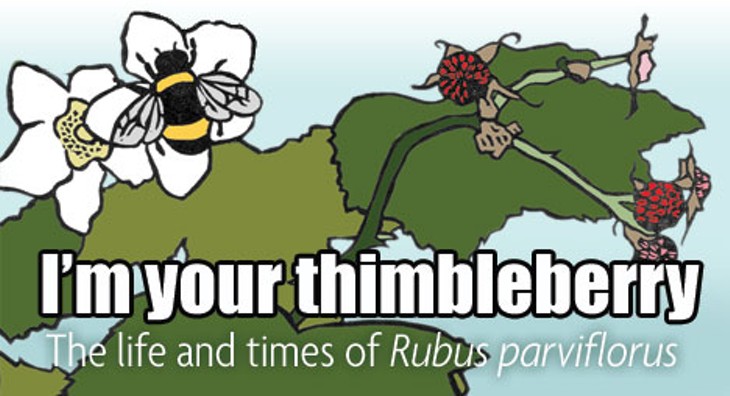

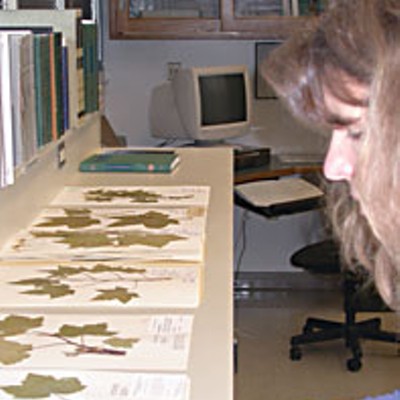
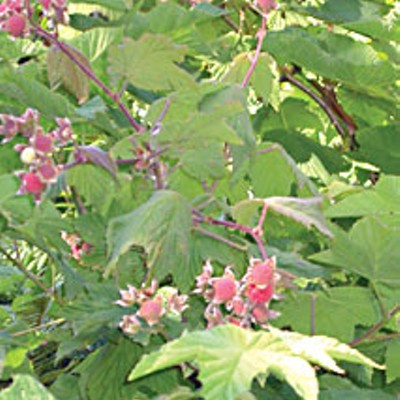
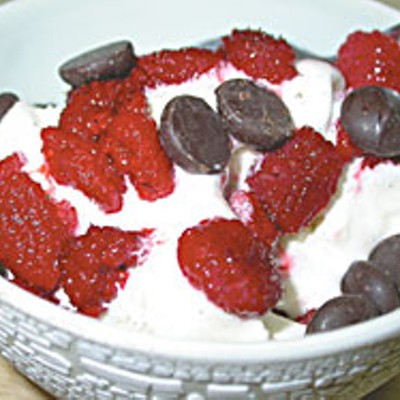
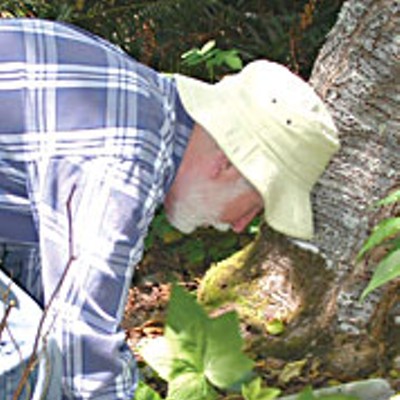
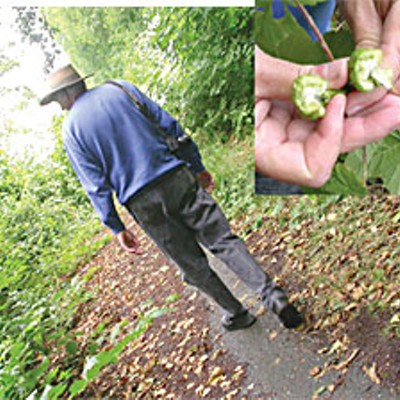
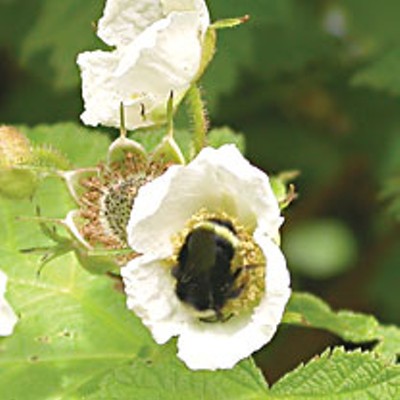
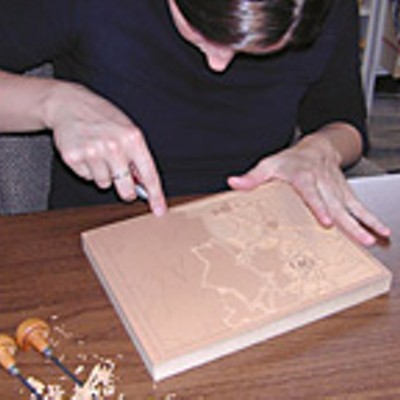


Comments (4)
Showing 1-4 of 4